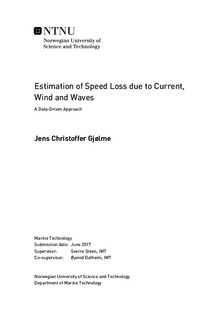| dc.description.abstract | There is an increasing demand from customers, governments and maritime authorities when it comesto emission control and energy efficiency in the maritime industry. Demands in efficiency requires amore systematic approach to the modeling of marine operations such that implementation of operationaloptimization is possible. A prerequisite for optimization of marine operations, is accurate calculation orreliable estimation of speed loss. In a seaway, factors such as direct wind and wave action, and indirecteffects of waves linked with ship motions, may cause considerable speed loss. Over the years, substantialeffort has been devoted to understanding the influence of wind and waves on a ship in sea passage, buta simple yet complete model does not exist. Coinciding with the increasing demand for efficiency, thereis a trend towards digital transformation of businesses. Included in this transformation is the logging ofoperational data. This data, together with other data sources, such as weather hind- and forecast datapresents an opportunity for a new approach for estimation and prediction of speed loss. This thesis aimsto make use of the digitalization trend to develop a new method for estimation and prediction of speedloss through machine learning.The method that has been develop solves the estimation and prediction problem by breaking the problemdown into two parts. Using data from ship operations combined with weather hindcast data, a databaseis created. From this database, data which conforms to some calm water condition is collected in a calmwater subdatabase. This calm water subdatabase is used to train a custom nonlinear regression modelfor the estimation of a calm water reference speed V_cw with trim, draft, and shaft power as inputs. V_cw represents an estimate of the ship speed in a calm seastate, for a specific set of draft, trim, and shaft power. V_cw is used, in conjunction with a measurement of actual speed through water, to calculate a speed lossquantity for the full database. A neural network regression model is then trained on the database topredict speed loss. The result is a speed loss prediction model, valid for the ship(s) that generated thedata.The custom nonlinear regression model has been formulated based on fundamental physical relationshipsbetween the input and target variables. Validation studies based on expected correlations and comparisonwith similar models has been performed. The quality of the speed loss estimates depends on the availablecalm water data. To ensure that the artificial neural network regression model generalizes well, a strategyfor training has been developed. Regularization by implementation of early stopping results in availablecomputing power being the factor that decides the number of hidden units in the hidden layer. Dependingon the input variables, the neural network regression model is able to predict speed loss with with anapproximate average error of between 2-5%, which corresponds to an error on knots of about 0.3-0.7 forthe average calm water speed. | |

